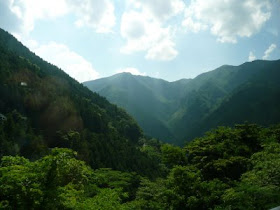THE NEXT DAY, I arrived at Okuiya Niju Kazurabashi, or the twin bridges. I walked down a hundred steps to the bridge are still visible spectral-tangle of vines stretching over the river rapids. Local residents believe the bridge is higher and long known as the man, and the lower bridges and short are known as women. Floating fog, blurring the panorama of hills and surrounding areas.
Of all presented in the Iya Valley-mountains, temples and hot springs-this is the place I visited as recommended mandatory Fumiaki. "The bridge was reportedly built by the Clan Heikie in the 12th century, when they fled from Kyoto after losing the civil war to the Genji clan," he said. "Heike live in the interior mountains, and they built this bridge for protection. This Shikoku relics of the past. "
A gust of wind shook the bridge, the
rain made the slippery wooden boards. Giddy, I set foot on a wooden board
first. I regret using the sandals, not proper footwear. I stepped up and took a
deep breath, step foot next to a wooden board. Hap!
I slip up, sat down, and my feet wedged between the wooden planks. I tried to pull it out, and the rough tangle of vines hurt my feet. Suddenly everything seemed so close: Wood, fog, spirits of the Heike warriors.
"Yeah residents still believe the gods lived in the mountains," Fumiyaki once said to me, and now I understand why. I seemed to hear them giggling from behind the trees.
Finally I managed to get away from the tongs wooden planks and vines. This time, I was extra cautious step and both hands clinging to the rod of the bridge. Focus, focus. I walked slowly, swaying and creaking bridge. After 10 minutes of heart is pounding, I reached across and spontaneous jumping for joy. I imagine Fumiyaki and pray to the god of the mountain.
ROOM ON MAIN
temple complex in Zentsuji, hanging spiral
incense and monks sang solemn hymns,
while a half-dozen parents bowed and
prayed; outside, the young monk sweeping
the yard. At one
point, a group of Japanese tourists admiring the five-story pagoda towering: four women
with chic hairstyle
murmur audible ooh and aah at the front of the cinnamon
tree which looked older than the temple.
Zentsuji is the cradle of
Buddhist and leaders Kobo Daishi, who built
this temple in
the early ninth century. It
is recommended Kuniko
father, Ojiichan. "To understand Shikoku," said
Ojiichan, and pilgrim-o-henro-san-walking from
temple to temple for
virtue and chastity. As a child, every time the pilgrims approached the house we will hear the sound of the bells ting-ting-and they bring
mom told me to bring
rice and oranges for
them. Therefore, we cordially welcome the stranger in Shikoku.
In this complex there is a gift shop that sells books, beads,
crutches, and other
pilgrimage equipment. I carefully read the
picture book tells the journey of
Kobo Daishi legend,
until he felt the
time passed so quickly. When I
came out, looked everywhere for pilgrims using conical
bamboo hats, jackets
and white pants. I approached the couple and the child's seizures.
When I asked their
trip, the girl grabbed my backpack and pulled out a book bound in red
silk and gold. "In
every temple, the priests wrote the name of temple
on one page and affix
seal of the temple," said the father. Her fingers turn a page. "Every time a pilgrimage, I feel
enlightened.
This pilgrimage reminds me of the meaning of life. After the pilgrimage, I was able to do everything, "he continued.
"Of course," said his daughter, "It's only the fourth round. O-henro-san over there "- he pointed to an elderly man wearing black clothes and colorful belts-" he made rounds to 333! "
I am sure, the
pilgrims thankful for Shikoku. They
walked slowly in humility, reminding us
not to make a fuss and commit to
a higher spiritual purpose. I realized the
truth of the words Ojiichan
tradition hospitality and kindness of the island.
I circled the island for two days,
to feel the texture of old hay and straw-clay material village house, lounging
in a quiet fishing village, bow pilgrims pay homage to the people I have met.
In hot water spa, a half-dozen middle-aged women were friendly, forced to pay
my dinner. When I got lost in the intersection, the truck driver was kind
enough to drive me. At a roadside snack stall, the owner asked me if I was on a
pilgrimage, and when I said no and claimed to have been looking for the heart
of Shikoku , he exclaimed, "Then you are also a pilgrim!"
And presented me with strawberry shaved ice.
In the afternoon, on the fifth day,
I arrived at Johen.
Family Kuniko was awaiting my arrival. We enjoyed dining Katsuo sashimi (fresh raw fish
meat) and grilled fish, as well as mushrooms, tomatoes, cucumbers fresh from
the garden.
While sitting on tatami mats around a low table, Obaachan look with sparkling eyes. "All right," he said, "the success you find Shikoku heart?"
"Of course," I replied, and all eyes looked at me expectantly. "But I do not only find it in one place. I found it on lading agriculture, fishing village, also on the pilgrims who would not stop to give thanks for the gifts of the day. And again I found it on the people around were greeted with enthusiasm and friendliness. "
For a moment, I was not sure Kuniko
family understand my words in Japanese just were not at all fluent. But then
they nodded and smiled.
Ojiichan poured beer for us all and raises his glass. "Don-san, glad you are finally back home. Kanpai! "
Together we sipped drinks, then obaachan raised his glass again. "And this time I'm glad you're not stuck in the ditch again!"





No comments:
Post a Comment